Estimate of Hurricane Wind Speed from AMSR-E Low-Frequency Channel Brightness Temperature Data
Abstract
:1. Introduction
2. Data
2.1. Microwave Brightness Temperature Data
2.2. H*Wind Analysis Data
2.3. Airborne SFMR Measurements
2.4. Data Collections
3. Method
4. Results and Analysis
4.1. Comparison of the Klein-Swift Model and The Ellison Model
4.2. Wind Speed Retrieval and Validation for AMSR-E
4.3. Rain Effects on Wind Retrieval
5. Conclusions
Acknowledgments
Author Contributions
Conflicts of Interest
References
- Jones, W.L.; Black, P.G.; Delnore, V.E.; Swift, C.T. Airborne microwave remote-sensing measurements of hurricane Allen. Science 1981, 214, 274–280. [Google Scholar] [CrossRef] [PubMed]
- Uhlhorn, E.W.; Black, P.G. Verification of remotely sensed sea surface winds in hurricanes. J. Atmos. Ocean. Technol. 2003, 20, 99–116. [Google Scholar] [CrossRef]
- Yueh, S.; Stiles, B.W.; Liu, W.T. QuikSCAT wind retrievals for tropical cyclones. IEEE Trans. Geosci. Remote Sens. 2003, 41, 2616–2628. [Google Scholar] [CrossRef]
- Williams, B.A.; Long, D.G. Estimation of hurricane winds from SeaWinds at ultrahigh resolution. IEEE Trans. Geosci. Remote Sens. 2008, 46, 2924–2935. [Google Scholar] [CrossRef]
- Stiles, B.W.; Dunbar, R.S. A neural network technique for improving the accuracy of scatterometer winds in rainy conditions. IEEE Trans. Geosci. Remote Sens. 2010, 48, 3114–3122. [Google Scholar] [CrossRef]
- Zabolotskikh, E.; Mitnik, L.; Chapron, B. GCOM-W1 AMSR2 and MetOp-A ASCAT wind speeds for the extratropical cyclones over the North Atlantic. Remote Sens. Environ. 2014, 147, 89–98. [Google Scholar] [CrossRef]
- Fernandez, D.; Carswell, J.R.; Frasier, S.; Chang, P.S.; Black, P.G.; Marks, F.D. Dual-polarized C- and Ku-band ocean backscatter response to hurricane-force winds. J. Geophys. Res. 2006, 111, C08013. [Google Scholar] [CrossRef]
- Horstmann, J.; Thompson, D.R.; Monaldo, F.; Iris, S.; Graber, H.C. Can synthetic aperture radars be used to estimate hurricane force winds? Geophys. Res. Lett. 2005, 32, L22801. [Google Scholar] [CrossRef]
- Shen, H.; Perrie, W.; He, Y. A new hurricane wind retrieval algorithm for SAR images. Geophys. Res. Lett. 2006, 33, L21812. [Google Scholar] [CrossRef]
- Reppucci, A.; Lehner, S.; Schulz-Stellenfleth, J.; Yang, C.S. Extreme wind conditions observed by satellite synthetic aperture radar in the North West Pacific. Int. J. Remote Sens. 2008, 29, 6129–6144. [Google Scholar] [CrossRef]
- Horstmann, J. Tropical cyclone winds from C-band cross-polarized synthetic aperture radar. IEEE Trans. Geosci. Remote Sens. 2015, 53, 2887–2898. [Google Scholar] [CrossRef]
- Quilfen, Y.; Prigent, C.; Chapron, B. The potential of QuikSCAT and WindSat observations for the estimation of sea surface wind vector under severe weather conditions. J. Geophys. Res. 2007, 112, C09023. [Google Scholar] [CrossRef]
- Shibata, A. A wind speed retrieval algorithm by combining 6 and 10 GHz data from advanced microwave scanning radiometer: Wind speed inside hurricanes. J. Oceanogr. 2006, 62, 351–359. [Google Scholar] [CrossRef]
- Meissner, T.; Wentz, F.J. Wind vector retrievals under rain with passive satellite microwave radiometers. IEEE Trans. Geosci. Remote Sens. 2009, 47, 3065–3083. [Google Scholar] [CrossRef]
- Zhang, L.; Yin, X.B.; Shi, H.Q.; Wang, Z.Z. Hurricane Wind Speed Estimation Using WindSat 6 and 10 GHz Brightness Temperatures. Remote Sens. 2016, 8, 721. [Google Scholar] [CrossRef]
- Hong, S.; Seo, H.J.; Kwon, Y.J. A unique satellite-based sea surface wind speed algorithm and its application in tropical cyclone intensity analysis. J. Atmos. Ocean. Technol. 2016, 33, 1363–1375. [Google Scholar] [CrossRef]
- Yan, B.; Weng, F. Applications of AMSR-E measurements for tropical cyclone predictions part I: Retrieval of sea surface temperature and wind speed. Adv. Atmos. Sci. 2008, 25, 227–245. [Google Scholar] [CrossRef]
- Reul, N. SMOS satellite L-band radiometer: A new capability for ocean surface remote sensing in hurricanes. J. Geophys. Res. 2012, 117, C02006. [Google Scholar] [CrossRef]
- Yueh, S. Directional signals in Windsat observations of hurricane ocean winds. IEEE Trans. Geosci. Remote Sens. 2008, 46, 130–136. [Google Scholar] [CrossRef]
- Reul, N. A revised L-band radio-brightness sensitivity to extreme winds under Tropical Cyclones: The five year SMOS-storm database. Remote Sens. Environ. 2016, 180, 274–291. [Google Scholar] [CrossRef]
- Powell, M.D.; Houston, S.H.; Amat, L.R. The HRD real-time hurricane wind analysis system. J. Wind Eng. Ind. Aerodyn. 1998, 77, 53–64. [Google Scholar] [CrossRef]
- Houston, S.H.; Shaffer, W.A.; Powell, M.D. Comparisons of HRD and SLOSH surface wind fields in hurricanes: Implications for storm surge modeling. Weather Forecast. 1999, 14, 671–686. [Google Scholar] [CrossRef]
- Uhlhorn, E.W. Hurricane surface wind measurements from an operational stepped frequency microwave radiometer. Mon. Weather Rev. 2007, 135, 3070–3085. [Google Scholar] [CrossRef]
- Klotz, B.W.; Uhlhorn, E.W. Improved stepped frequency microwave radiometer tropical cyclone surface winds in heavy precipitation. J. Atmos. Ocean. Technol. 2014, 31, 2392–2408. [Google Scholar] [CrossRef]
- Tropical Cyclone Forecasters’s Reference Guide. Available online: http://www.nrlmry.navy.mil/%7Echu/index.html (accessed on 11 March 2016).
- Klein, L.A.; Swift, C.T. An improved model for the dielectric constant of sea water at microwave frequencies. IEEE J. Ocean. Eng. 1977, 2, 104–111. [Google Scholar] [CrossRef]
- Liebe, H.J.; Hufford, G.A.; Manabe, T. A model for the complex permittivity of water at frequencies below 1 THz. Int. J. Infr. Millim. Waves 1991, 12, 659–675. [Google Scholar] [CrossRef]
- Ellison, W. New permittivity measurements of seawater. Radio Sci. 1998, 33, 639–648. [Google Scholar] [CrossRef]
- Reynolds, W.R.; Smith, T.M. Improved global sea surface temperature analyses using optimum interpolation. J. Clim. 1994, 7, 929–948. [Google Scholar] [CrossRef]
- Webster, P.J.; Holland, G.J.; Curry, J.A. Changes in tropical cyclone number, duration, and intensity in a warming environment. Science 2005, 309, 1844–1846. [Google Scholar] [CrossRef] [PubMed]
- Hilburn, K.A.; Wentz, F.J. Intercalibrated passive microwave rain products from the unified microwave ocean retrieval algorithm (UMORA). J. Appl. Meteorol. Climatol. 2008, 47, 778–794. [Google Scholar] [CrossRef]
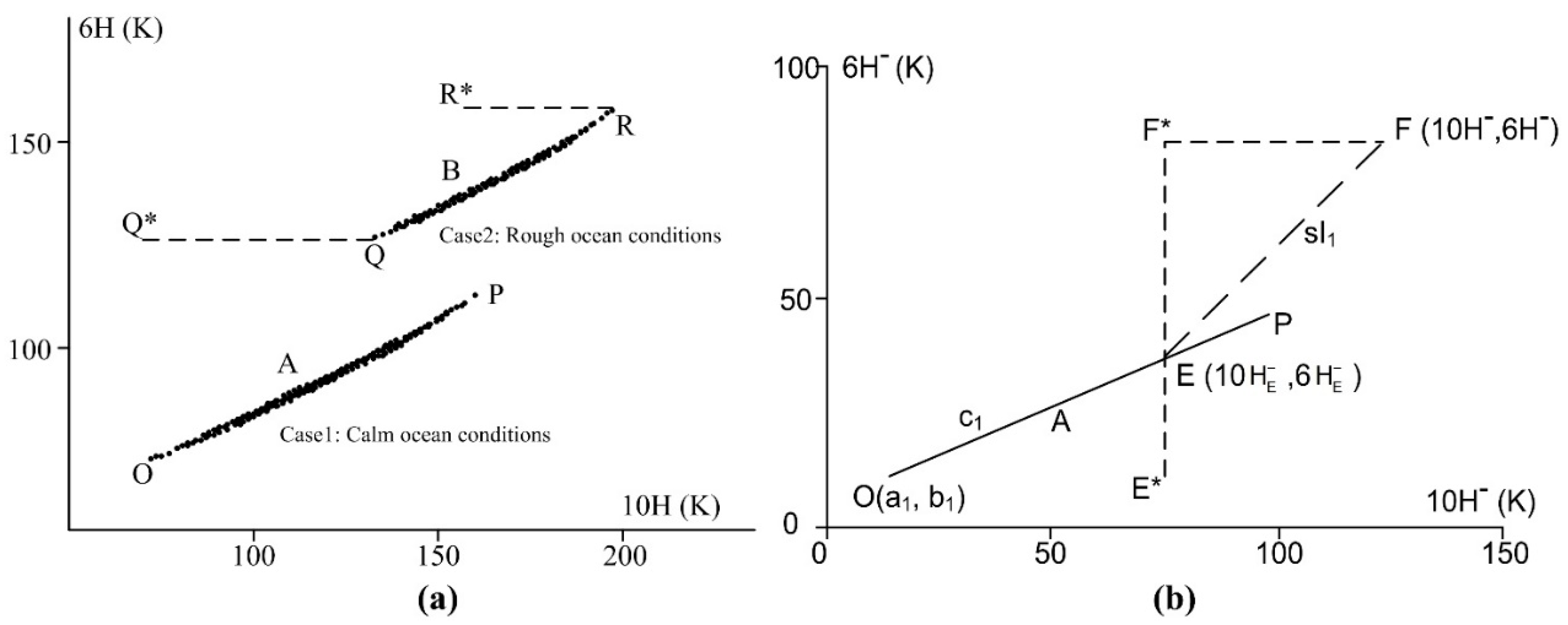
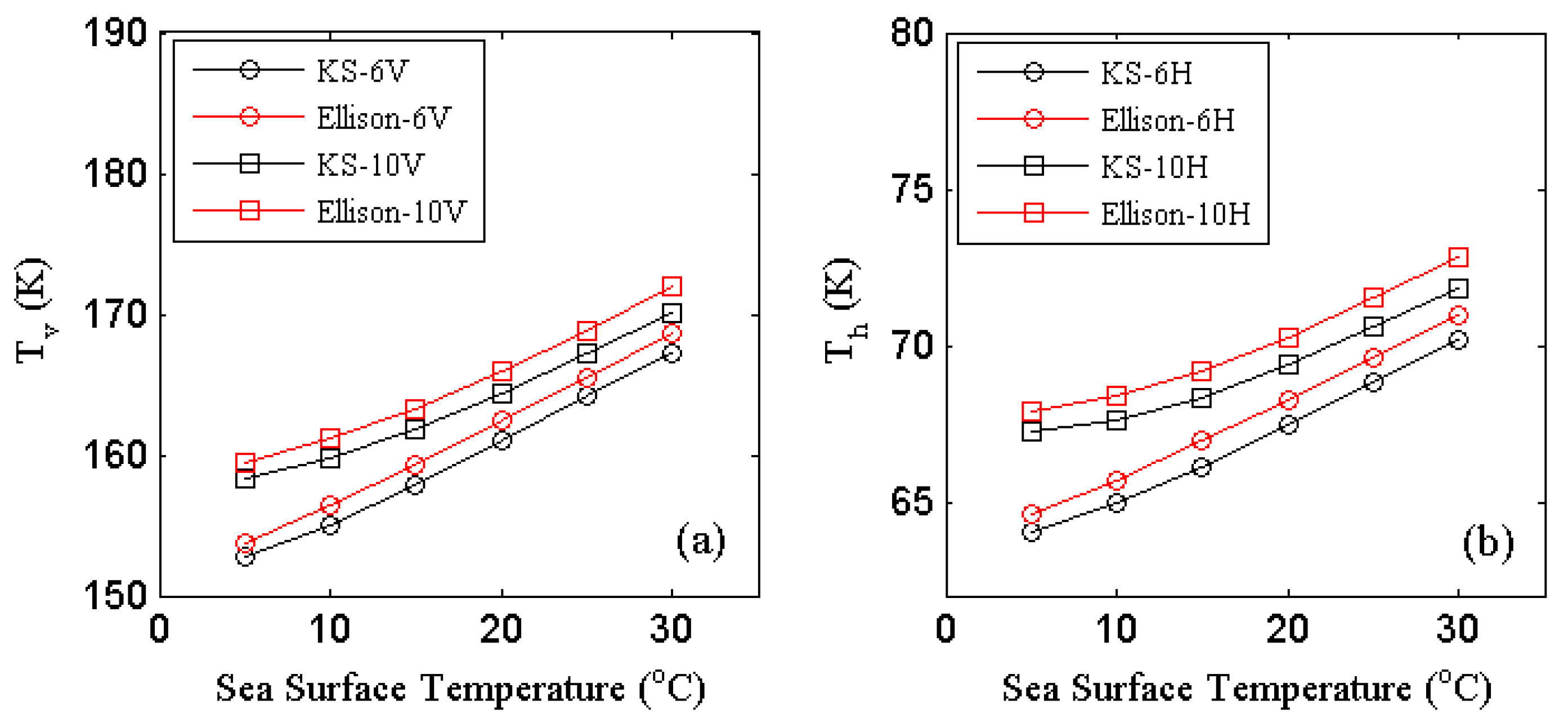
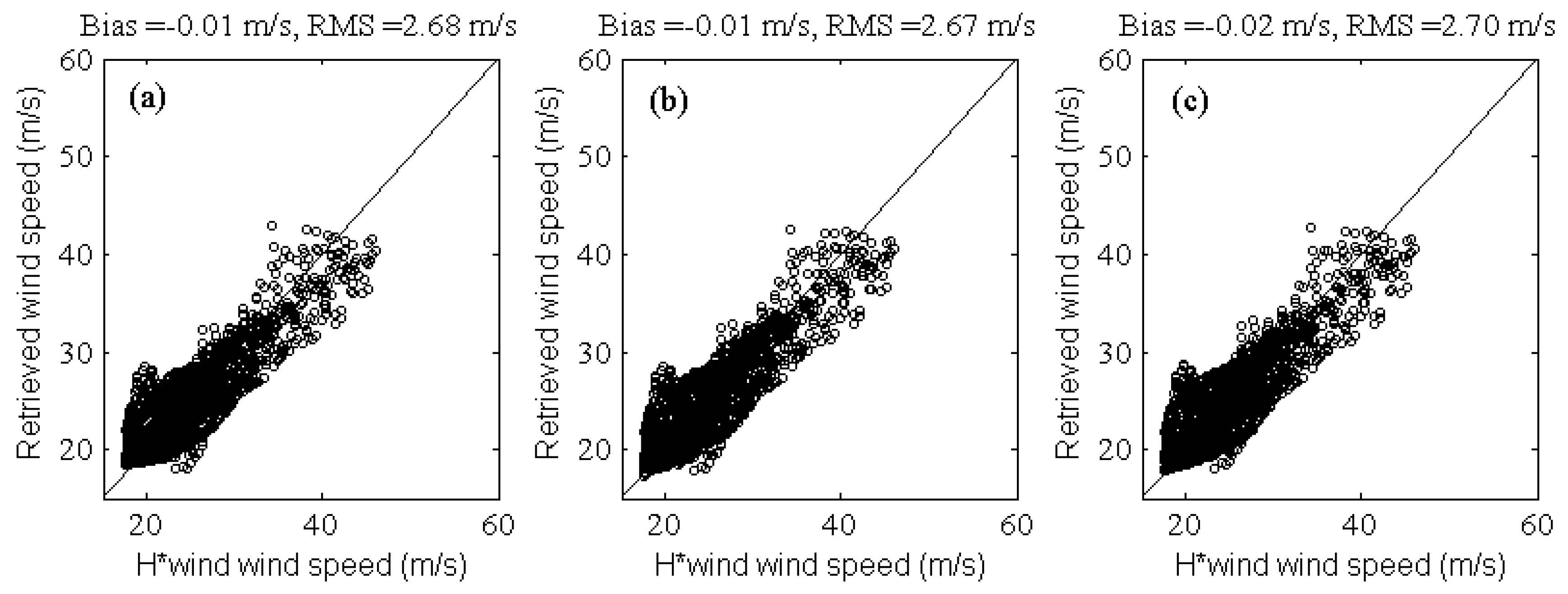
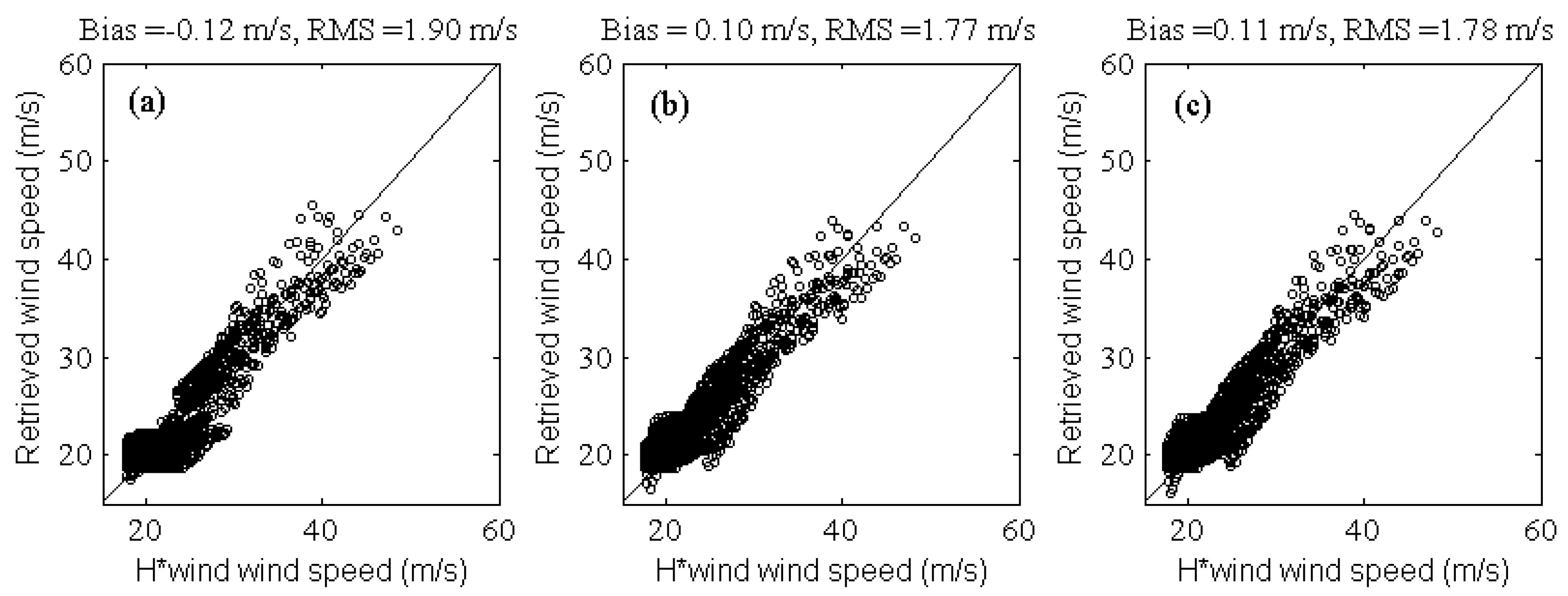
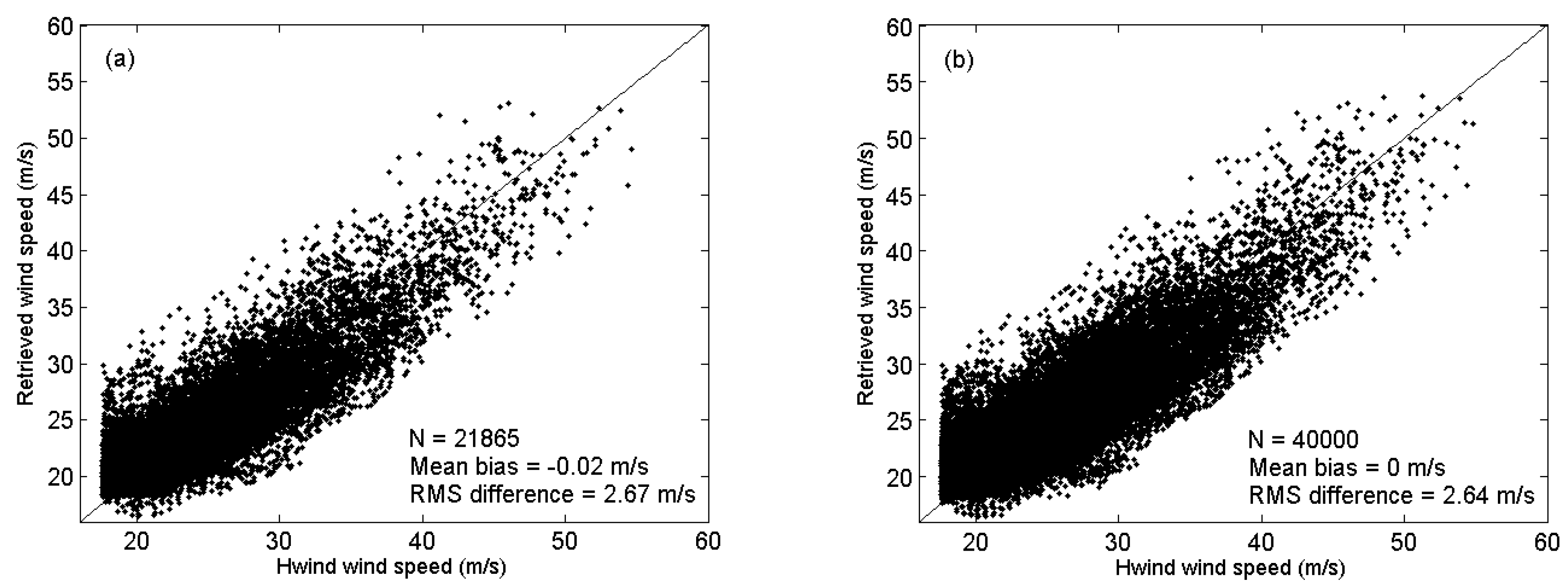
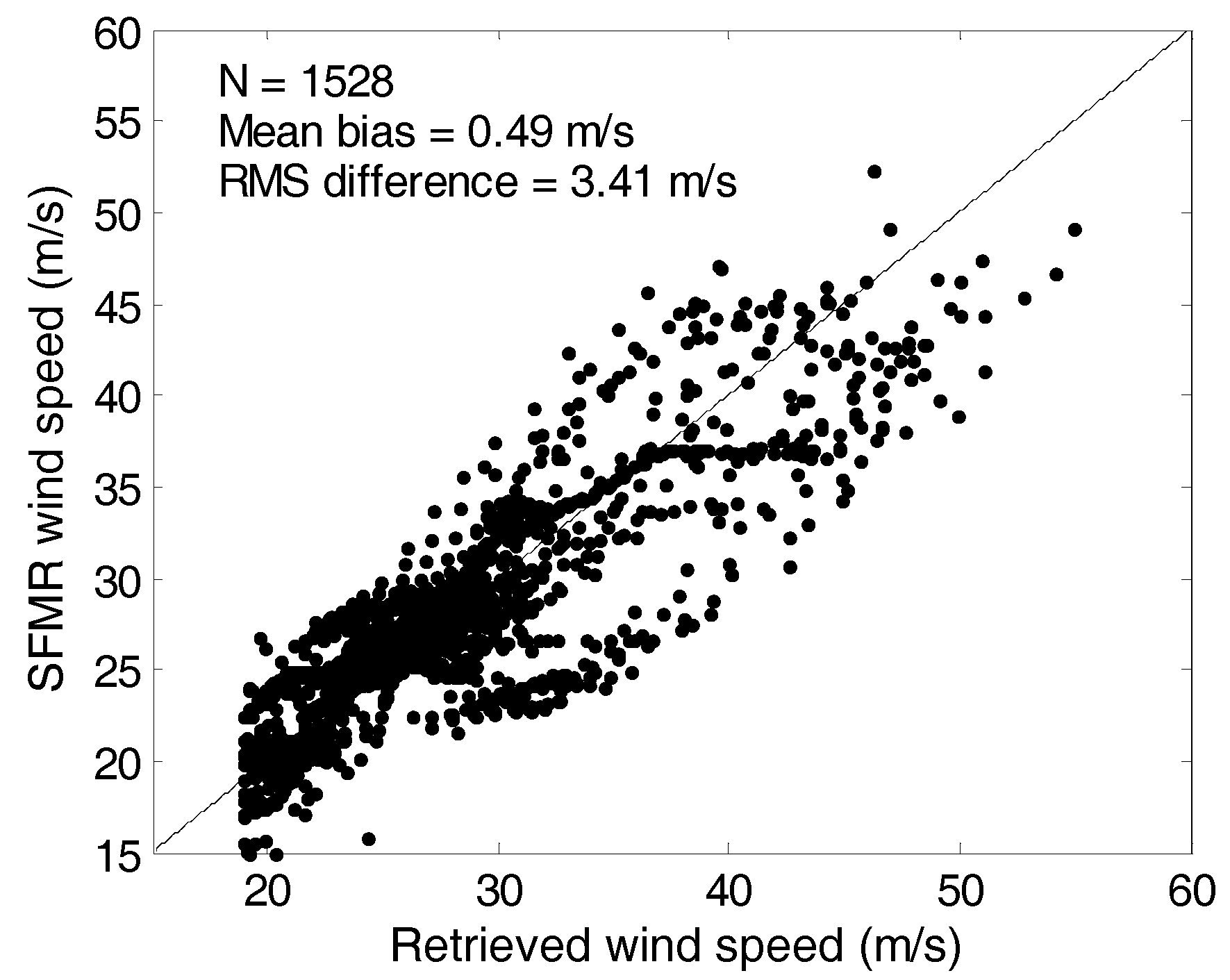
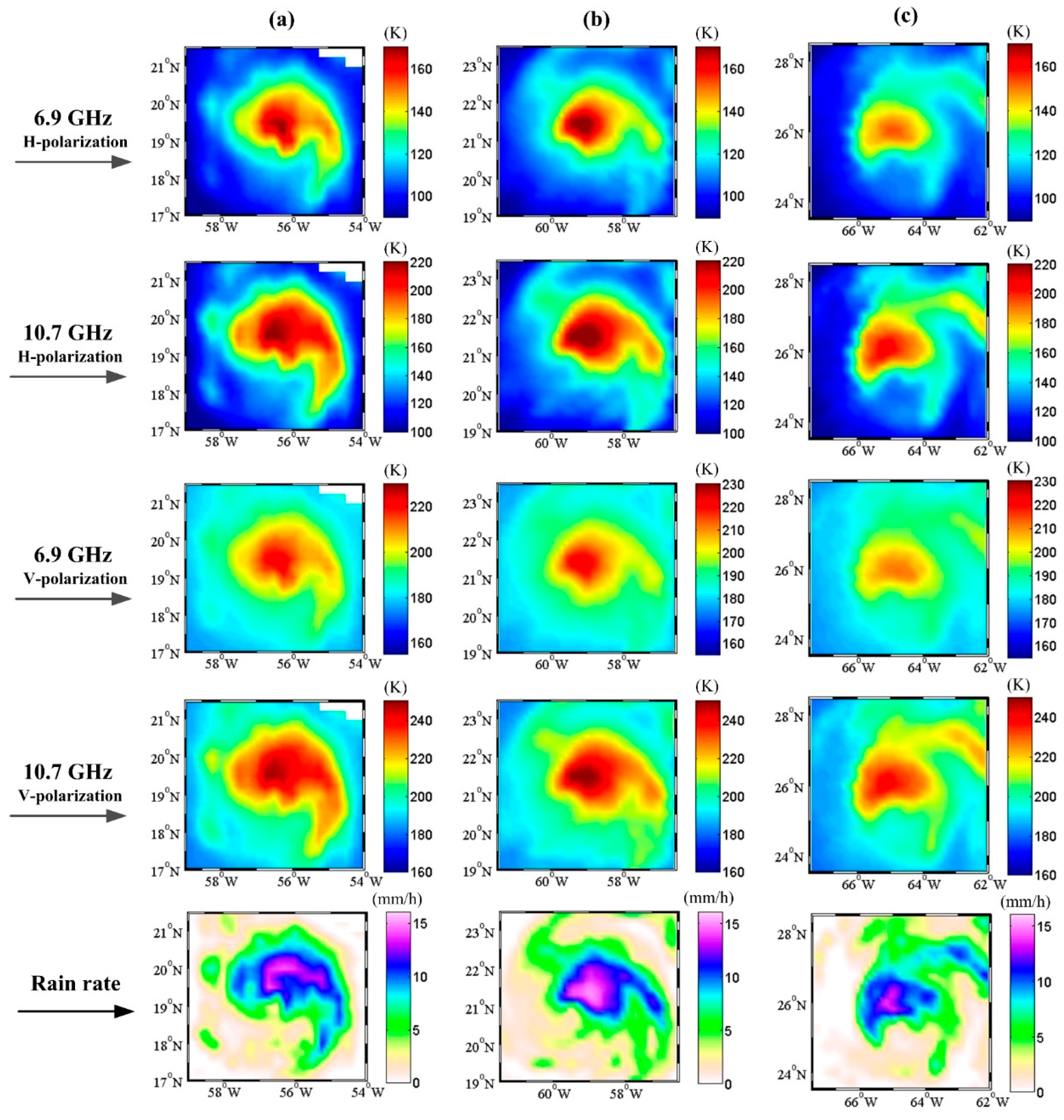
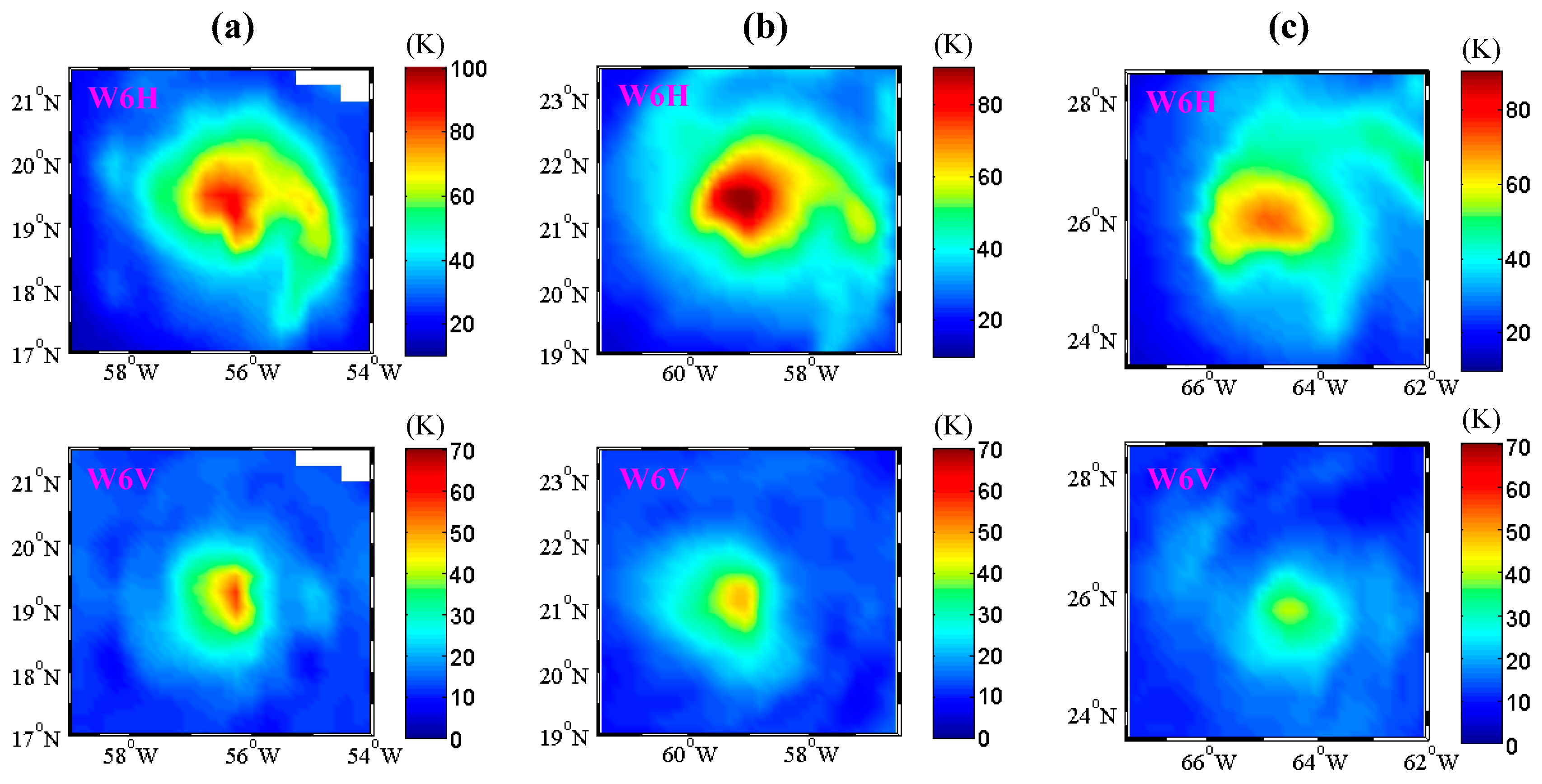




| Hurricane Name | Year | Max Winds (m/s) | AMSR-E–H*wind | ||
|---|---|---|---|---|---|
| Population (≥18 m/s) | Longitude Shift (°) | Latitude Shift (°) | |||
| Fabian | 2003 | 60 | 8919 | 0.044 | 0.110 |
| Isabel | 2003 | 73 | 6766 | −0.205 | 0.107 |
| Frances | 2004 | 58 | 3452 | −0.463 | 0.112 |
| Ivan | 2004 | 70 | 11,054 | −0.260 | 0.103 |
| Dennis | 2005 | 65 | 2365 | −0.149 | 0.110 |
| Katrina | 2005 | 75 | 2276 | −0.020 | 0.025 |
| Rita | 2005 | 78 | 427 | −0.318 | −0.012 |
| Bertha | 2008 | 53 | 721 | −0.064 | 0.198 |
| Ike | 2008 | 63 | 7087 | −0.040 | −0.037 |
| Bill | 2009 | 58 | 6381 | −0.470 | 0.310 |
| Igor | 2010 | 68 | 7668 | −0.321 | 0.199 |
| Irene | 2011 | 54 | 4749 | −0.137 | 0.239 |
| Hurricane Name | Hurricane Frances (2004) | Hurricane Rita (2005) | ||||||
|---|---|---|---|---|---|---|---|---|
| Sea Surface Temperature (°C) | 27 | 28 | 29 | 30 | 27 | 28 | 29 | 30 |
| Mean bias (m/s) | −0.03 | −0.02 | −0.02 | −0.02 | 0.12 | 0.11 | 0.11 | 0.12 |
| RMS difference (m/s) | 2.74 | 2.73 | 2.70 | 2.77 | 1.81 | 1.80 | 1.78 | 1.81 |
| a1 | b1 | c1 | d1 | e1 | f1 |
| 16.9925 | 5.5757 | 0.1201 | 0.8826 | 0.0153 | 0.0007 |
| a2 | b2 | c2 | d2 | e2 | f2 |
| 13.9971 | 5.6516 | 0.5158 | 0.8193 | 0.0012 | 0.0005 |
| m1 | m2 | m3 | m4 | m5 | m6 |
| 0.0050 | 0.0182 | 18.0131 | 0.2087 | 0.1588 | 12.0432 |
| m7 | m8 | m9 | |||
| 0.1536 | 0.4107 | 10.6057 |
| Rain Interval (mm/h) | Average Rain Rate (mm/h) | Number | Mean Bias (m/s) | RMSD (m/s) |
|---|---|---|---|---|
| [0, 2] | 0.56 | 26193 | −0.04 | 1.98 |
| [2, 4] | 2.98 | 8031 | 0.20 | 2.49 |
| [4, 6] | 5.05 | 7364 | −0.15 | 2.70 |
| [6, 8] | 7.04 | 6761 | −0.17 | 2.94 |
| [8, 10] | 9.02 | 5648 | −0.09 | 3.19 |
| [10, 12] | 10.98 | 4226 | −0.34 | 3.49 |
| [12, 14] | 12.93 | 2736 | −0.12 | 3.65 |
| Above 14 | 14.63 | 916 | 0.15 | 3.72 |
© 2018 by the authors. Licensee MDPI, Basel, Switzerland. This article is an open access article distributed under the terms and conditions of the Creative Commons Attribution (CC BY) license (http://creativecommons.org/licenses/by/4.0/).
Share and Cite
Zhang, L.; Yin, X.-b.; Shi, H.-q.; He, M.-y. Estimate of Hurricane Wind Speed from AMSR-E Low-Frequency Channel Brightness Temperature Data. Atmosphere 2018, 9, 34. https://doi.org/10.3390/atmos9010034
Zhang L, Yin X-b, Shi H-q, He M-y. Estimate of Hurricane Wind Speed from AMSR-E Low-Frequency Channel Brightness Temperature Data. Atmosphere. 2018; 9(1):34. https://doi.org/10.3390/atmos9010034
Chicago/Turabian StyleZhang, Lei, Xiao-bin Yin, Han-qing Shi, and Ming-yuan He. 2018. "Estimate of Hurricane Wind Speed from AMSR-E Low-Frequency Channel Brightness Temperature Data" Atmosphere 9, no. 1: 34. https://doi.org/10.3390/atmos9010034
APA StyleZhang, L., Yin, X.-b., Shi, H.-q., & He, M.-y. (2018). Estimate of Hurricane Wind Speed from AMSR-E Low-Frequency Channel Brightness Temperature Data. Atmosphere, 9(1), 34. https://doi.org/10.3390/atmos9010034






